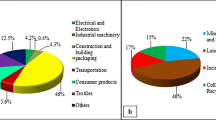Abstract
Bio-based polyurethane (PU) was synthesized from waste cooking oil-based polyol for application as host in solid polymer electrolyte. The effect of varying wt% of lithium iodide (LiI) salt as charge carriers was studied. The polymer electrolyte films were characterized using Fourier transform infrared (FTIR), electrochemical impedance spectroscopy, scanning electron microscope (SEM), differential scanning calorimeter and thermogravimetric analysis. The shifting of absorption peaks for amine (N–H), carbonyl (C=O) and ether (C–O–C) groups observed in FTIR analysis showed that the PU-LiI complexation had occurred. The highest ionic conductivity obtained was at 30% LiI with value of 4.67 × 10−6 Scm−1. SEM revealed the good miscibility between lithium salt and PU. These properties exhibited the potential of waste cooking oil-based PU as alternative host for solid polymer electrolyte.







Similar content being viewed by others
References
Dzulkurnain NA, Ahmad A, Mohamed NS (2015) P(MMA-EMA) random copolymer electrolytes incorporating sodium iodide for potential application in a dye-sensitized solar cell. Polymers. doi:10.3390/polym7020266
Daud FN, Ahmad A, Badri KH (2014) An investigation on the properties of palm-based polyurethane solid polymer electrolyte. Int J Polymer Sci 2014:326716-1–326716-5. doi:10.1155/2014/326716
Ibrahim S, Ahmad A, Mohamed NS (2015) Characterization of novel castor oil-based polyurethane polymer electrolytes. Polymers 7(4):747–759. doi:10.3390/polym7040747
Tahir SM, Norfirdaus W, Salleh W, Syahamatun N, Hadid N, Enderus NF (2016) Synthesis of waste cooking oil-based polyol using sugarcane bagasse activated carbon and transesterification reaction for rigid polyurethane foam. Mater Sci Forum 846:690–696. doi:10.4028/www.scientific.net/MSF.846.690
Badri KH (2012) Biobased polyurethane from palm kernel oil-based polyol: polyurethane. Polyurethanes. doi:10.5772/47966
Su’Ait MS, Ahmad A, Badri KH, Mohamed NS, Rahman MY, Ricardo CLA, Scardi P (2014) The potential of polyurethane bio-based solid polymer electrolyte for photoelectrochemical cell application. Int J Hydrogen Energy 39:3005–3017. doi:10.1016/j.ijhydene.2013.08.117
Das B, Konwar U, Mandal M, Karak N (2013) Sunflower oil based biodegradable hyperbranched polyurethane as a thin film material. Ind Crop Prod 44:396–404. doi:10.1016/j.indcrop.2012.11.028
Yeganeh H, Hojati-Talemi P (2007) Preparation and properties of novel biodegradable polyurethane networks based on castor oil and poly(ethylene glycol). Polym Degrad Stab 92:480–489. doi:10.1016/j.polymdegradstab.2006.10.011
Jalilian S, Yeganeh H (2015) Preparation and properties of biodegradable polyurethane networks from carbonated soybean oil. Polym Bull 72:1379–1392. doi:10.1007/s00289-015-1342-3
Ullah Z, Bustam MA, Man Z (2014) Characterization of Waste palm cooking oil for biodiesel production. International Journal of Chemical Engineering and Applications. doi:10.7763/IJCEA.2014.V5.366
Ferraro LG, Bastos F, Alvarenga DS, Gelfuso MV, Thomazini D (2014) Investigation to obtain polyols from residual frying oil. Mate Sci Forum. 776:351–356. doi:10.4028/www.scientific.net/MSF.775-776.351
Akintayo CO, Akintayo ET, Thomas Z, Babalola BM (2013) Newly developed epoxy-polyol and epoxy- polyurethane from renewable resources. British Journal of Applied Science and Technology 3:984–993
Hazmi ASA, Aung MM, Abdullah LC, Salleh MZ, Mahmood MH (2013) Producing Jatropha oil-based polyol via epoxidation and ring opening. Ind Crops Prod 50:563–567. doi:10.1016/j.indcrop.2013.08.003
Daud FN, Ahmad A, Badri KH (2013) Preparation and characterization of plasticized palm-based polyurethane solid polymer electrolyte. In: AIP conference proceedings, vol 1571. pp 775–781. doi:10.1063/1.4858749
Azeman NH, Yusof NA, Abdullah J, Yunus R, Hamidon MN, Hajian R (2015) Study on the spectrophotometric detection of free fatty acids in palm oil utilizing enzymatic reactions. Molecules. doi:10.3390/molecules200712328
Nohra B, Candy L, Blanco JF, Guerin C, Raoul Y, Mouloungui Z (2013) From petrochemical polyurethanes to biobased polyhydroxyurethanes. Macromolecules 46:3771–3792. doi:10.1021/ma400197c
Wong CS, Badri KH (2012) Chemical analyses of palm kernel oil-based polyurethane prepolymer. Mater Sci Appl. 2012:78–86
Daud FN, Ahmad A, Haji K (2015) Characterisations of palm-based polyurethane solid polymer electrolyte. 1107:163–167. doi:10.4028/www.scientific.net/AMR.1107.163
Wong CS, Badri KH, Ataollahi N, Law KP, Su MS, Hassan NI (2014) Synthesis of new bio-based solid polymer electrolyte effect of NCO/OH ratio on their chemical, thermal properties and ionic conductivity. Int J Chem Nuclear Mater Metall Eng 8:1168–1175
Chaurasia SK, Singh RK, Chandra S (2014) Ionic liquid assisted modification in ionic conductivity, phase transition temperature and crystallization kinetics behaviour of polymer poly(ethylene oxide). Sol State Ion 262:790–794. doi:10.1016/j.ssi.2013.09.048
Daud FN, Ahmad A, Haji Badri K (2014) An investigation on the properties of palm-based polyurethane solid polymer electrolyte. Int J Polym Sci. doi:10.1155/2014/326716
Ahmad A, Rahman MYA, Low SP, Hamzah H (2011) Effect of LiBF 4 salt concentration on the properties of plasticized MG49-TiO 2 based nanocomposite polymer electrolyte. Int Sch Res Netw. doi:10.5402/2011/401280
Santhosh P, Gopalan A, Vasudevan T, Lee KP (2006) Preparation and characterization of conducting poly(diphenylamine) entrapped polyurethane network electrolyte. J Appl Polym Sci 101:611–617. doi:10.1002/app.23326
Lavall RL, Ferrari S, Tomasi C, Marzantowicz M, Quartarone E, Magistris A (2010) Novel polymer electrolytes based on thermoplastic polyurethane and ionic liquid/lithium bis (trifluoromethanesulfonyl) imide/propylene carbonate salt system. J Power Sour 195:5761–5767. doi:10.1016/j.jpowsour.2010.03.085
Acknowledgements
The author would like to extend their gratitude to the MARA University of Technology and University of Malaya for facility support. This work is also supported by fundamental research grants [600-RMI/RAGS 5/3 (15/2014)].
Author information
Authors and Affiliations
Corresponding author
Rights and permissions
About this article
Cite this article
Salleh, W.N.F.W., Tahir, S.M. & Mohamed, N.S. Synthesis of waste cooking oil-based polyurethane for solid polymer electrolyte. Polym. Bull. 75, 109–120 (2018). https://doi.org/10.1007/s00289-017-2019-x
Received:
Revised:
Accepted:
Published:
Issue Date:
DOI: https://doi.org/10.1007/s00289-017-2019-x




